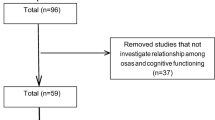Abstract
Seventeen patients with sleep apnea syndrome [SAS, Respiratory Disturbance Index (RDI) = 12−85] were compared with 16 normal controls (RDI < 7) on neuropsychological tests of executive functions, a domain in which SAS patients have been suggested to have deficits. SAS patients demonstrated greater deficits in the retrieval of information from semantic memory (Controlled Oral Word Association task) and in shifting responses in the face of error (Wisconsin Card Sort Test), but differences in working memory were not observed. Eliciting deficits in cognitive executive functions in SAS may require more sensitive measures than are typically used in neuropsychiatric research.
Similar content being viewed by others
References
Greenberg GD, Watson R, Deptula D. Neuropsychological dysfunction in sleep apnea. Sleep 1987;10:254–262
Bedard MA, Montplasir J, Richer F, Rouleau I, Malo J. Obstructive sleep apnea syndrome: Pathogenesis of neuropsychological deficits. J Clin Exp Neuropsychol 1991;13:950–964
Naegele B, Thouvard V, Pepin J, et al. Deficits of cognitive executive functions in patients with sleep apnea syndrome. Sleep 1995;18:43–52
Lezak MD. Neuropsychological assessment, 3rd ed. New York, Oxford University Press, 1995
Goldman-Rakic PS. Cortical localization of working memory. In: McGaugh J, Weinberger N, Lynch G (eds.): Brain organization and memory: Cells, systems, and circuits. New York, Oxford University Press, 1990, pp 285–298
Park S, Holzman PS. Schizophrenics show spatial working memory deficits. Arch Gen Psychiatry 1992;49:975–982
Adams NL, Redline S, Browner I, Strauss. Impact of mild and moderate levels of sleep apnea on neuropsychological function and mood. J International Neuropsychol Soc 1995;1:138
Hoddes E, Zarcone VP, Smythe H, et al. Quantification of sleepiness: A new approach. Psychophysiology 1973;10:431–436
Carskadon MA, Dement WC, Mitler MM, Roth T, Westbrook PR, Keenan S. Guidelines for the multiple slep latency test (MSLT): A standard measure of sleepiness. Sleep 1986;9:519–524
Kim HC, Young T, Matthews CG, Weber SM, Woodard AR, Palta M. Sleep-disordered breathing and neuropsychological deficits: A population-based study. Am J Respir Crit Care Med 1997;156:1813–1819
Braghiroli A, Sacco C, Carli S, Campini R, Fringuelli FM, Donner CF. Cerebral single photon emission photography (SPET) in obstructive sleep apnea patients before and after 6 months of treatment. Am J of Respir Crit Care Med 1998;157:A778
Tainturier C, Hausser-Hauw C, Rakotonanahry D, Fleury B. Regional cerebral blood flow in obstructive sleep apnea syndromes by SPECT. Am J Respir Crit Care Med 1998;157:A778
Author information
Authors and Affiliations
Additional information
Supported by NIH NHLBI SCOR HL 42215 and the Department of Veterans Affairs.
Rights and permissions
About this article
Cite this article
Lee, M.M., Strauss, M.E., Adams, N. et al. Executive Functions in Persons with Sleep Apnea. Sleep Breath 3, 13–16 (1999). https://doi.org/10.1007/s11325-999-0013-8
Issue Date:
DOI: https://doi.org/10.1007/s11325-999-0013-8




